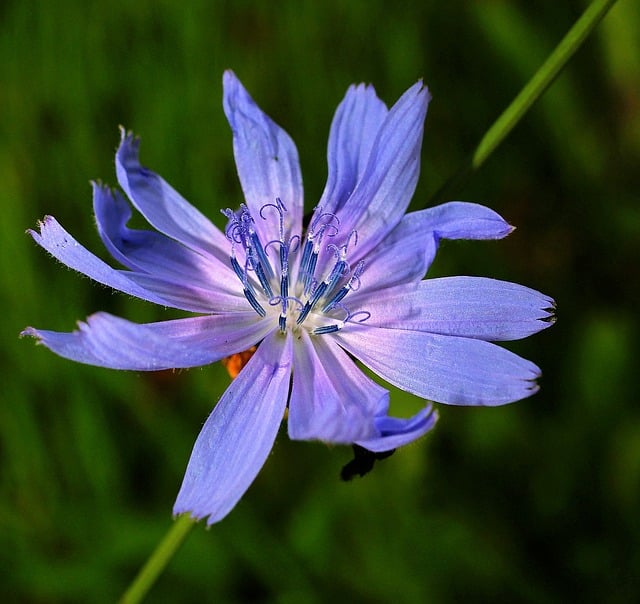One of the recent projects financed by the EU Horizon 2020 funding programme is the CHIC project, which plans to develop chicory varieties that can be used to produce both healthy dietary fibres and healthy terpenes. The project will be using New Plant Breeding Techniques and evaluate the technological performance of these technologies, as well as the safety, environmental, regulatory, socio-economic and broader societal issues associated with them.
The CHIC project aims to develop chicory varieties that can be used to produce dietary fibre with enhanced prebiotic effects to promote gut health and terpenes with promising health effects. The €7.3 million project supports the establishment of a responsible innovation pathway for the development and application of new plant breeding techniques (NPBTs) for chicory as a multipurpose crop for the production of high-value consumer products, in line with societal needs and concerns. The consortium leading the project brings together a carefully selected team of 17 internationally leading industrial, academic and public participants from 11 European countries and one from New Zealand. Among the industry partners is Sensus. European Seed reached out to Matthew de Roode, Innovation Manager at Sensus for his views on CHIC.
European Seed (ES): Matthew, can you tell me a bit more about your company’s involvement in the CHIC project?
Matthew de Roode (MdR): Sensus is a manufacturer of inulin and oligofructose from chicory. As part of the Cosun Cooperative, adding value for our farmers is always an important part in our strategy. Therefore, the focus of our innovation program is on increasing chicory value by looking at the production process, looking at the (higher) valorisation of current side streams and finding new applications for our products. We actively collaborate with our Cosun Innovation Center and scientific partners, like Wageningen University. In an early stage of the project we were asked by Wageningen University if we would be interested to participate in the CHIC project. The CHIC project focusses on adding value to the chicory root by optimising the production of the already commercialised health ingredients (inulin) and exploring the health potential of currently non-commercial ingredients (the terpenes). Evidently, the project enables a strong positioning for chicory as a multipurpose crop enabling Sensus to add value for its shareholders.
ES: Why it is important that the EU spends money on boosting chicory?
MdR: Chicory is a healthy, robust crop that doesn’t have high needs like nutrients. Unfortunately, it is currently a very marginal crop with a relatively low interest from commercial parties for large improvement investments. The positioning in CHIC as a multipurpose crop that can produce different health related ingredients can give chicory the boost that it deserves.
ES: Inulin is more and more used to replace sugar and fat. Will inulin be able to stop the obesity epidemic?
MdR: It is a fact that inulin and oligofructose play an important role in fat and sugar reduction, due to the ease of application and the good taste profile. As such both inulin and oligofructose contribute to a healthier lifestyle. However, the obesity epidemic is the result of a complex combination of different effects and is not so easy to attribute to only sugar and fat reduction.
ES: The project plans on using new plant breeding techniques. However, the ECJ recently ruled that such techniques should be regulated as GMO’s. Isn’t that a drawback for the project?
MdR: The research itself can still continue, but indeed this ruling can have a detrimental effect if we want to implement the potential results of this project. On the other hand, the CHIC projects will also explore the health potential of different ingredients from the chicory root which will show the multipurpose potential of this crop, regardless of the breeding technique.
European Seed (ES): Some say there is a growing opposition against innovation, including in agriculture and the seed sector. What is your take on this?
MdR: Any 2-year-old is playing with mobile devices instead of toys or dolls and the general public embraces a lot of (small scale) initiatives in food production, so I do not agree that there is a growing opposition against innovation. A growing trend that is clearly visible is the desire for healthy food and more information about how our food is produced. People just want to know where their food is coming from, so I see that as an open invitation to us to give that information as a company. Education on how our food is made and why certain choices are made when producing food on a large scale is the first step in acceptance of the methods that we use.
ES: How will the private breeding sector be involved in the CHIC project?
MdR: One of the project partners in the CHIC project is Keygene, serving as a private breeding partner. In addition, several stakeholders like the European Seed Association are represented in the stakeholder advisory group.
ES: Do you expect that the outcome can be translated to other crops?
MdR: Although this is not my expertise, I have seen several examples of new plant breeding techniques in other crops in the literature. So, initially I think that chicory can benefit from the experience in other crops. After this project, of course new learnings can be applied in other crops.
Where on the web: https://www.inspiredbyinulin.com/











